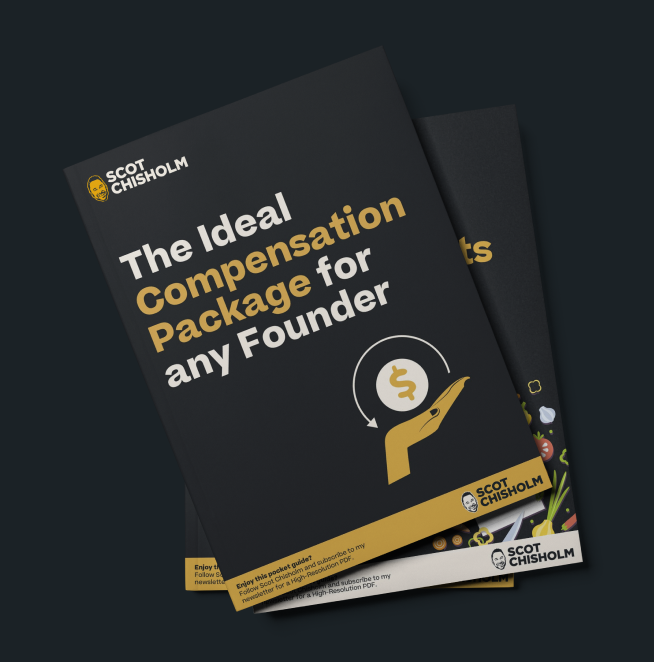
Written by Scot Chisholm
| April 12, 2024

Most leaders think of the all-hands meeting as a necessary evil. A formality to check the culture box. Something to get through as quickly as possible to get back to the “real work.”
And most employees dread the meeting as well. They can tell that leadership is just going through the motions. And there’s little thought put into the structure and content.
But what most leaders don’t realize is that the all-hands isn’t just another meeting.
It’s one of the most powerful leadership tools at their disposal.
A well-executed all-hands meeting can rally your team, align everyone around key priorities, and create momentum that propels your company for months or even years. It can be an EXTREMELY high leverage 60-90 minutes!
On the other hand, a poorly run all-hands can deflate morale, create confusion, and make your team question where the company is headed.
It’s a high-stakes event that requires thoughtful preparation.
So what separates an unforgettable all-hands from a forgettable one? After 20 years of trial and error, I’ve built an all-hands format that hits every time.
Let’s dive in.
The first key to a great all-hands is getting the frequency right. Meet too often, and it becomes a drain. Too infrequently, you lose touch with your team.
The stage of your company matters. I recommend the following:
But here’s the thing—regardless of frequency & length, you can’t just wing it and expect the magic to happen. Leading an effective all-hands requires thoughtful planning and purposeful execution.
That’s where having my trusty all-hands framework comes in…
My philosophy is simple: prioritize quality over quantity. Make each all-hands a must-attend event that people really look forward to. Spend the time to get the content right, and your team will leave informed, inspired, and fired up. It’s an injection of energy that can last months. Your goal is to have it last (at least) until the NEXT all-hands meeting – where you then rinse and repeat!
I think of the all-hands agenda as a series of building blocks—or “agenda blocks”—that you select and sequence for each meeting. Each agenda block contains themed content that delivers a specific message or takeaway for all attendees. When the different types of agenda blocks are combined, they create a dynamic and impactful meeting that people will remember for a very long time.
There are three types of agenda blocks to build your all-hands agenda:
The key is making sure you have AT LEAST one included in EVERY all-hands meeting you lead. The order of these agendas can vary from meeting to meeting (see below).
It’s also fine to double up on one type of block. For example, two Purpose agenda blocks in one meeting. Or two Direction blocks in another.
When I’m building the agenda, I think to myself: what does the team need more of right now? Purpose? Direction? Or Progress? The answer is highly dependent on the state of the culture and the performance of the company at that given time.
For example, one meeting might look like this:
All-hands Agenda Blocks:
This means you’re going to add two types of purpose-themed content to the agenda this time around. I would do this if I felt like we’ve been too money-focused and were getting disconnected from our ‘why.’
But another meeting might look like this:
All-hands Agenda Blocks:
This means that we’ll be spending a lot of time diving into progress against our goals. This might happen right after the close of the quarter, or it might happen when we’re falling behind on a lot of goals.
Now that you understand the types of agenda blocks let’s dive into the details of each one below 👇
Reinforcing your company’s mission and “why” is one of the most vital yet overlooked aspects of an all-hands. The Purpose agenda block of your all-hands meeting helps answer the question:
Why are we here?
And in the whirlwind of the day-to-day, it’s easy for people to lose sight of the bigger picture. This block is essential for helping people connect their purpose (their ‘why’) to the company’s. This connection drives motivation and helps people get through the tough stretches (that we all have!).
Here are a few examples of content that could fill the Purpose agenda block:
These are just a few examples, and I’m sure you can think of many more.
I list them all on a Google Doc or note for myself. You’ll start seeing inspiration for agenda content everywhere. Then, before each meeting, when I know I need to fill a Purpose agenda block, I have a great list to pull from. This makes planning 100x easier and less stressful.
The Direction agenda block of your all-hands meeting is where you provide directional clarity to the team and ensure everyone is rowing in the same direction. It helps answer the question:
Where are we going?
It’s about making your longer-term vision AND your shorter-term goals crystal clear to everyone, regardless of position.
Here are a few examples of content that could fill the Direction agenda block:
The more specific and tangible you can be, the better. Your team should walk away with a clear understanding of the company’s direction and all the points along the way.
Remember, you can never over-communicate direction. It’s like turning a light on in a dark room for your team. Suddenly, everyone can see the path forward and confidently move in the right direction.
Progress is a powerful motivator. When people see that their efforts are making a tangible difference, they become energized to keep going, to lean in.
So, the “progress” agenda block in your all-hands meeting is where you update the team on progress against your goals. This section also recognizes individual (or team) progress.
It helps answer the question:
How are we doing?
Here are a few examples of content that could fill the Progress agenda block:
Celebrating wins also cultivates a sense of pride and collective ownership. It shows that you’re all in this together, working toward a common goal.
But showcasing progress isn’t just about patting yourselves on the back. It’s also an opportunity for honest reflection on areas for improvement. If you’re falling short in certain areas, don’t sweep it under the rug. Openly acknowledge it and involve your team in brainstorming for solutions.
The key is to strike a balance. Aim for a tone of realistic optimism—acknowledging the hard work ahead while celebrating the milestones you’ve achieved together. That’s the kind of balanced, motivating message that will leave your team feeling inspired and eager to tackle the next challenge.
With your agenda-building blocks in place, it’s time to consider the overarching narrative you want to convey. If someone were to remember just one message from the all-hands meeting, what would that be? And how do you weave that message into each agenda block—purpose, Direction, Progress—throughout the meeting? This overarching message becomes the common thread that ties it all together.
For example, let’s say this is your core message: We need to re-focus on our customers.
You might build the following all-hands agenda:
You get the idea!
The all-hands meeting isn’t just about presenting stuff to your team as the leader. If you want to take things to the next level, find ways to make your all-hands interactive.
Here are a few ways to add an interactive element to your all-hands:
This kind of interactivity transforms your all-hands from a passive experience into an active conversation. And giving your team a voice sends a powerful signal that their input matters. You are co-creating on this journey together – not just feeding them directions.
Some of the best ideas in my companies came from the interactive elements at my all-hands meetings. You never know what breakthroughs might surface when you open the floor.
—
Now, you’ve got the framework to transform your all-hands meeting from a snoozefest to an incredibly high-leverage meeting that will align and energize your team for months!
Just remember to focus on the fundamental “building blocks” – Purpose, Direction, Progress—and you’ll be better off than 99% of your competition.
Are you a founder, executive, or manager? I’d love to support your professional growth.
Here are three ways:
Join 100,000+ leaders getting the blueprint to go from $0 to $100M.
July 12, 2024
Our own worst enemies We all want to be great leaders. We read the top 10 books, watch the TED talks, and try to follow in the footsteps of those who’ve made it big. But...
I'd love to learn more about you to better customize the tips I send, ensuring they are as relevant and helpful as possible.


Hi, I’m Scot — Join 100,000+ leaders getting
the blueprint to go from $0 to $100M.